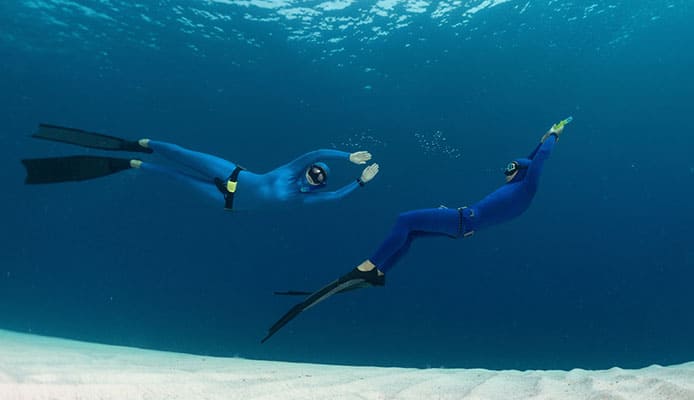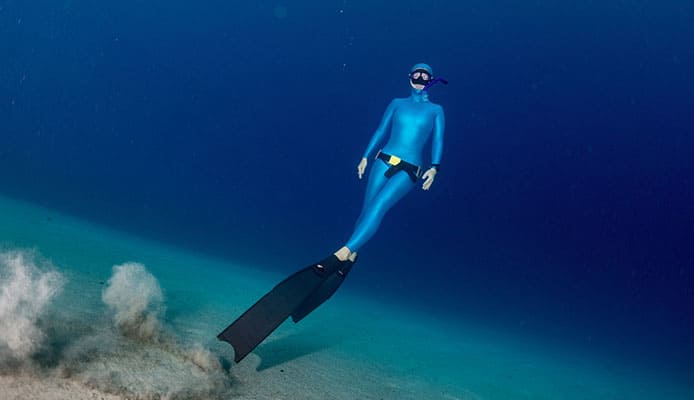
Most freedivers will weigh themselves to be buoyant on the surface. This helps boost diving safety. As a diver, you have to ensure that you have the ability to stay at the surface after a full exhale.
If you happen to get into problems, you would want to make it easy for your freediving buddy to rescue you. An additional reason why freedivers wear lead weights is to reach the desired depth as quickly as possible.
New freedivers are generally not very familiar with freediving weights and freediving weight belt. We have crafted this article to eliminate the mystery that exists when it comes to the freediving weight belt and freediving weights.
Factors Influencing Freediving Weights
The amount of weight you will need after wearing your freediving fins will depend on various factors. The factors include:
Body Composition
Body composition has a huge effect on buoyancy. Muscle and bone are somewhat negatively buoyant while fat is somewhat positively buoyant.
Other tissues usually feature a density that is close to that of water. The freediving weights for someone whose body features more fat than muscle will be different from those of someone who has more muscle than fat.
Wetsuit Thickness
Freedivers wear freediving weights to compensate for the extra buoyancy created by their freediving wetsuits. To stay warm when diving in colder waters, you will need a thicker weight suit. Therefore, more weight will be necessary to create the ideal level of buoyancy.
Whether You Will Be Diving in Salt or Fresh Waters
On average, a cubic foot of saltwater will weigh 64.1 pounds. A cubic foot of freshwater will weigh about 62.4 pounds. For this reason, any diver will be more positively buoyant in salt water than he or she will be when in freshwaters. He/she will, therefore, need to adjust his or her weights accordingly.
When in freshwaters, most divers will need approximately 6 to 8% of their body weight in added weight. In saltwater, this figure ranges between 8 and 10%.
The Diver’s Gender
Generally, men are denser than women. In the majority of the situations, men do not need weight at all. They also do not require to add buoyancy to keep them from sinking after exhaling.
Freediving Weighing Systems
Various freediving weighing systems are available. When choosing a weighting system, you need to ensure that you can get rid of the weighting system easily. Any weighting system you choose to use after donning your freediving watch should be quick release, either for you or your buddy. This will make it possible for you to return to the surface quickly in the event of trouble.
The Freediving Weight Belt
The majority of freedivers prefer to wear a freediving weight belt. The weight belt is usually fitted tightly around their hips, giving the diver enough space to breathe diaphragmatically, with some small freediving weights spaced evenly around the diver’s body.
In the market, you will come across both rubber and nylon freediving weight belt. When compared to the nylon freediving weight belt, the rubber weight belts are much better. They offer the following benefits:
Good Stretch
Nylon will stay tight against your stomach. This restricts your ability to breathe. The elasticity offered by the rubber freediving weight belt provides a snug fit.
If you place the rubber weight belt properly around the hips, it will allow you easy, free breathing. The rubber usually expands and contracts to the water pressure. This offers maximum comfort when you are diving.
Rubber Stays in Place
The ideal way of wearing a freediving weight belt is to make sure that it stays around your hips. As your depth increases, the nylon freediving weight belt usually loosens. As you descend, there is a high likelihood of the nylon falling off.
If you are using a non-slip rubber freediving weight belt, you will not have to worry about losing the belt when navigating underwater. Rubber belts rarely slip up.
Your Weights Won’t Move Around
When using a nylon freediving weight belt, fixing the weights with weight stops is necessary. Without the weight stops, your freediving weights won’t stay where you need them to stay. They will keep moving around.
When using a freediving weight belt made of rubber, you won’t have to worry about the freediving weights moving around. The weights will stay where you place them.
Neck Weights
On top of using a freediving weight belt, most divers will add a neck weight to help with trimming the body during dynamic disciplines. The neck freediving weights are also ideal for creating a more streamlined position during the free fall. It is not uncommon for some freedivers to use only the neck weights.
A major disadvantage of using the neck weights after wearing a freediving mask is that you need to have strong neck muscles to hold the head up when on the water surface. If you do not like the feeling of anything impeding your ability to hold your head up, neck freediving weights may not be ideal for you.
What Does Neutral Buoyancy Mean?
The term neutral buoyancy is used to refer to a balanced buoyancy where you neither sink nor float on the surface. For a diver to figure out where his or her neutral buoyancy point is, he/she needs a dive line and a dive computer.
Fin or pull down the line to approximately 10 meters, stop on the rope, let go, and then wait to see whether you will remain still, float up, or sink. If you remain still, then your current freediving weights setup is ideal for offering neutral buoyancy.
As mentioned earlier, buoyancy in fresh and saltwater varies. Therefore, your neutral buoyancy in saltwater may vary from the neutral buoyancy in freshwater.
Different Freediving Weighting for Varying Freediving Disciplines
Different freediving disciplines feature varying weighting. In this section, we will take a deeper look at the weighting and what you need to consider when setting up your weighting system.
Static Apnea (STA)
Freediving weight is not used. The freediver’s body is supposed to float easily at all times.
Dynamic Apnea with Fins (DYN)
This weighting system will depend on where the diver carries his/her buoyancy. Generally, women feature more positive buoyancy in their bottoms. For this reason, most women will benefit from wearing the freediving weight belt.
Men, on the other hand, carry much of their positive buoyancy in their heads. This means that they may benefit more from wearing a neck weight.
What you will be aiming for is to move your fin(s) and then glide without floating up to the surface or sinking to the bottom. This may take some experimenting to get right and may differ if you change your freediving equipment.
Dynamic Apnea Without Fins
The principles applied in dynamic with fins are ideal for dynamic without fins. However, getting the weighting right without fins is a little bit harder.
With fins, you will have the ability to correct your position in the water. Without fins, you will lack both propulsion and much control. Even a simple weight adjustment can create a lot of difference when you get in the water without fins.
Constant Weight Freediving with Fins (CWT)
To increase your safety underwater, you should be neutrally buoyant at a depth of about 10 to 12 meters, if you intend to dive deeper than 15 meters. The biggest shallow water blackout risk is at about 10 meters. Therefore, you must be positively buoyant from 10 meters.
Constant Weight Freediving Without Fins
The principles for constant weight freediving with fins also apply here. The tendency, however, is to wear more weight since the initial descent is generally more challenging. For safety reasons, you should wear less weight. This will make your ascent much easier.
Recreational Freediving
If you intend to dive on a shallow reef after wearing your diving gloves, you should adjust your weight so that you are a little bit heavily weighted while retaining positive buoyancy on the surface. Being neutrally buoyant at 10 meters can be frustrating if the seafloor is just 4 meters.
Free Immersion Diving
You should be neutral from about 10 meters. If you will be using free immersion techniques to practice equalization to shallower depths, increasing your freediving weights so that you will not be struggling to keep yourself at 3 meters could be more comfortable. When practicing equalization feet first, consider wearing some ankle weights to aid with streamlining.
Variable Weight Freediving
You won’t need any physical power to get to depth. You can benefit from a lower neutral buoyancy point. This will aid with the ascent.
Generally, no weight is worn. However, you can wear a freediving weight belt, with no weight, to help seal the suit. To aid with positive buoyancy, you may need to wear a thicker suit.
You might also like: Best Freediving Breathing Techniques
No Limits Freediving
You won’t need to wear any freediving weights. You should choose a suit that keeps you warm and also offers a bit of buoyancy.
Globo Surf Overview
To get your freediving weight right, experimenting may be necessary. In most cases, the weighting system will vary depending on a wide range of factors. For this reason, keeping a freediving logbook of what you had worn under similar conditions may be a good idea. Carrying some extra freediving weights for your freediving weight belt could help when you are fine-tuning your weight setup.
More Scuba Reviews:
- Dive Watches Under 500
- Ladies Dive Watch
- Underwater Scooter
- Scuba Regulator
- Rebreather
- What Is In A Scuba Tank
- How To Use A Dive Computer


